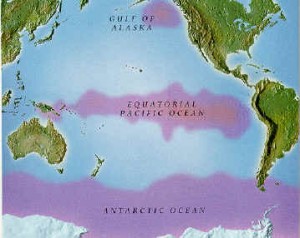
 If the marine productivity is iron limited, then adding iron should increase phytoplankton growth. This growth will absorb carbon dioxide from the atmosphere in order to fuel photosynthesis and on a global scale, has the potential to mitigate global warming by absorbing the extra carbon dioxide emitted by human activities. But is it really that simple?
If the marine productivity is iron limited, then adding iron should increase phytoplankton growth. This growth will absorb carbon dioxide from the atmosphere in order to fuel photosynthesis and on a global scale, has the potential to mitigate global warming by absorbing the extra carbon dioxide emitted by human activities. But is it really that simple?

After the first description of this hypothesis by John Martin, eight mesoscale experiments were conducted by scientists through the Woods Hole Oceanographic Institution, described in great detail on their project website. Basically, they concluded that although iron fertilization does encourage plankton growth, the carbon that is sequestered during that growth does not permanently stay sequestered in the ocean, but is released back into the atmosphere through decomposition. Therefore, even if the whole earth were fertilized, the sequestration would not be effective enough to make up for the use of coal-fired power plants.
~Bluegrass Blue Crab
I’m always amazed that at least until recently there were still papers being published about this. The experimental design was god-awful on a lot of those papers too: one only monitored growth for about a month and stayed in one spot as if ocean currents and the concept of sinking don’t exist. But still these projects kept getting funded (and they aren’t cheap to perform). I think the popularity of this idea and the willingness of people and institutions to throw money behind it really speak to the power of wishful thinking.